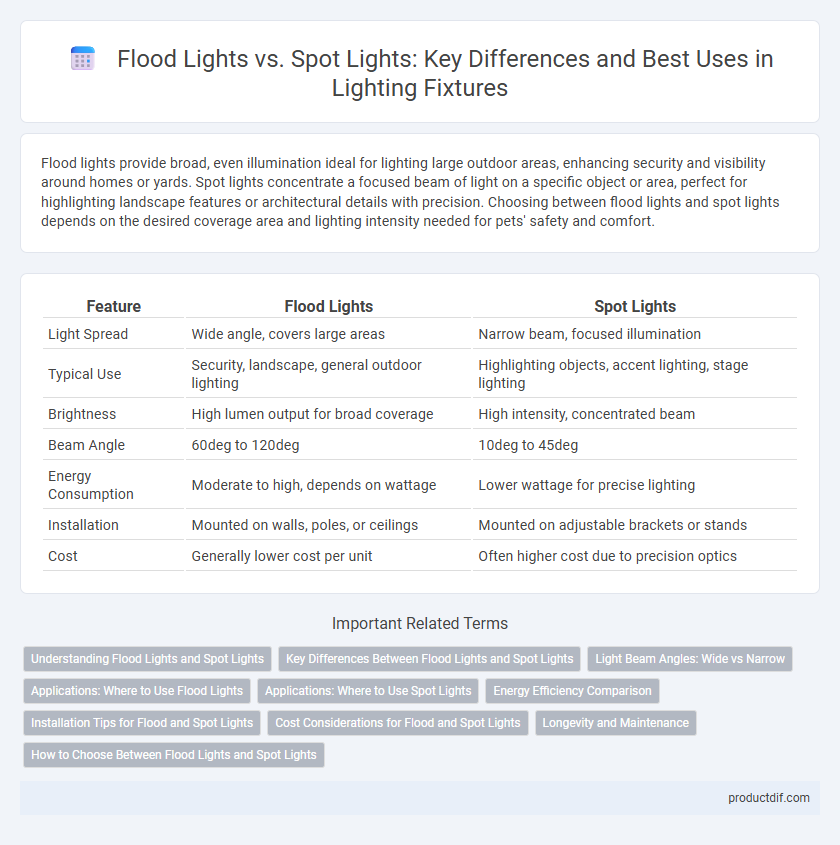Flood lights provide broad, even illumination ideal for lighting large outdoor areas, enhancing security and visibility around homes or yards. Spot lights concentrate a focused beam of light on a specific object or area, perfect for highlighting landscape features or architectural details with precision. Choosing between flood lights and spot lights depends on the desired coverage area and lighting intensity needed for pets' safety and comfort.
Table of Comparison
| Feature | Flood Lights | Spot Lights |
|---|---|---|
| Light Spread | Wide angle, covers large areas | Narrow beam, focused illumination |
| Typical Use | Security, landscape, general outdoor lighting | Highlighting objects, accent lighting, stage lighting |
| Brightness | High lumen output for broad coverage | High intensity, concentrated beam |
| Beam Angle | 60deg to 120deg | 10deg to 45deg |
| Energy Consumption | Moderate to high, depends on wattage | Lower wattage for precise lighting |
| Installation | Mounted on walls, poles, or ceilings | Mounted on adjustable brackets or stands |
| Cost | Generally lower cost per unit | Often higher cost due to precision optics |
Understanding Flood Lights and Spot Lights
Flood lights provide wide-angle, high-intensity illumination ideal for covering large outdoor areas such as parking lots, sports fields, and building facades. Spot lights emit a narrow, focused beam designed to highlight specific objects or areas like artwork, architectural details, or pathways. Understanding the beam angle, intensity, and application helps in selecting the right lighting fixture to enhance visibility and aesthetic appeal.
Key Differences Between Flood Lights and Spot Lights
Flood lights emit a wide, diffused beam designed to illuminate large outdoor areas, making them ideal for security and landscape lighting. Spot lights produce a narrow, focused beam for highlighting specific objects or architectural features with precision. The key differences lie in beam angle, brightness concentration, and typical applications, with flood lights covering broad zones and spot lights targeting detailed emphasis.
Light Beam Angles: Wide vs Narrow
Flood lights feature wide beam angles, typically ranging from 60 to 120 degrees, ideal for illuminating large areas such as yards, parking lots, and sports fields with uniform brightness. Spot lights have narrow beam angles, usually between 10 to 45 degrees, concentrating light on specific objects or areas for focused highlighting and accentuation. Choosing between flood lights and spot lights depends on the desired coverage and intensity of illumination, with wide beams providing broad dispersion and narrow beams offering precision targeting.
Applications: Where to Use Flood Lights
Flood lights are ideal for illuminating large outdoor areas such as parking lots, sports fields, and building facades, providing broad, uniform lighting that enhances security and visibility. They are commonly used in commercial settings, construction sites, and stadiums where wide coverage is essential. Their high-intensity beams effectively reduce dark spots and improve safety during nighttime activities.
Applications: Where to Use Spot Lights
Spot lights are ideal for highlighting specific areas or objects such as artworks, architectural details, or merchandise displays in retail environments. They provide focused, directional illumination that enhances visual interest and creates dramatic effects in stages, galleries, and outdoor landscapes. Their precise beam angle makes them perfect for creating accent lighting in both residential and commercial settings.
Energy Efficiency Comparison
Flood lights distribute light over a wide area, requiring higher wattage to achieve uniform brightness, which often results in increased energy consumption compared to spot lights. Spot lights concentrate light on a specific target, enabling lower wattage use and greater energy efficiency for focused illumination tasks. Choosing spot lights can significantly reduce electricity costs while providing precise lighting, whereas flood lights may be less efficient for energy-sensitive applications due to their broad coverage.
Installation Tips for Flood and Spot Lights
When installing flood lights, ensure wide-angle coverage by mounting them at higher positions such as eaves or poles for optimal illumination of large areas. Spot lights require precise aiming, so use adjustable brackets and secure fixtures firmly to avoid misalignment and to highlight specific features or focal points. Proper wiring with weatherproof connectors and compliance with local electrical codes is essential for both flood and spot light installations to ensure safety and longevity.
Cost Considerations for Flood and Spot Lights
Flood lights generally have a higher upfront cost due to their larger size and broader coverage area compared to spot lights. Spot lights tend to be more energy-efficient and cost-effective for highlighting specific objects or areas, requiring less power overall. Maintenance expenses for flood lights may be higher due to more complex installation and larger bulbs that consume more electricity.
Longevity and Maintenance
Flood lights typically offer longer lifespan due to their durable LED components designed for broad-area illumination, reducing the need for frequent replacements. Spot lights, while effective for focused lighting, often require more maintenance because their bulbs and lenses are subjected to higher heat concentration and potential damage. Choosing flood lights can result in lower long-term maintenance costs and enhanced durability in outdoor environments.
How to Choose Between Flood Lights and Spot Lights
Choosing between flood lights and spot lights depends on the lighting purpose and area coverage requirements. Flood lights deliver broad, uniform illumination ideal for large outdoor spaces like yards or parking lots, ensuring enhanced security and visibility. Spot lights concentrate a narrow beam for accentuating specific features or objects, making them perfect for highlighting architectural details or landscape elements.
Flood Lights vs Spot Lights Infographic

 productdif.com
productdif.com